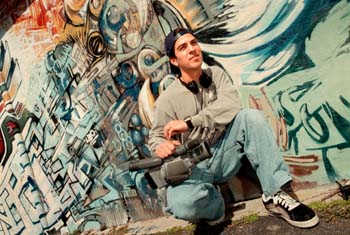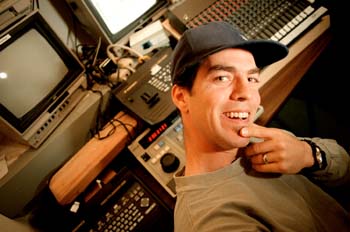![[MetroActive Movies]](/gifs/movies468.gif)
[ Movies Index | Metro Santa Cruz | MetroActive Central | Archives ]
The Reel World
It's All About the Benjamin: Santa Cruz's Benjamin Morgan explores the lives of at-risk teens in his second feature film, '420,' screening at UCSC's Oakes College next week.
Benjamin Morgan's socially charged adventures in filmmaking
By Karen Reardanz
WHEN BENJAMIN Morgan set out to make his first feature-length film, Coming Down, in the spring of 1997, he had two goals: to finish and to spend no money. He had no producers to please, no Screen Actors' Guild actors to pay. It was just him, the camera and a passion for filmmaking.
The 29-year-old Santa Cruz filmmaker met those goals by recruiting a cadre of family volunteers, relying on outside locales and friends' houses for shoots, and borrowing equipment and the facilities of downtown's Community Television, a spot that proved a fertile training ground for Morgan's cinematic vision.
What his celluloid experimentation yielded was a cohesive and intelligent, albeit rough, story of a pot-smoking, malt-liquor-pounding teen who chooses to leave his Santa Cruz hometown before his lifestyle destroys his future. Airing a handful of times on Community Television, Coming Down fueled Morgan with the experience to know that a $100,000 film school degree is not a prerequisite for creative filmmaking.
Coming Down also gave him the confidence to go through the whole grueling process all over again. The result is 420, Morgan's newest film, scheduled to air in early April on Community TV and set for a screening at UC-Santa Cruz's Oakes College next week. Shot entirely in black-and-white Hi-8 video, 420 is an engagingly dramatic look at a day in the life--April 20 to be exact--of a Santa Cruz teen.
Screen Testing
'MY goal is to produce three no-budget films and, in the process, learn as much about filmmaking as possible," Morgan explains.
"I always thought that [filmmaking] was my destiny," he laughs, "but I just didn't know how to go about it. But it was always in my blood."
After applying to and being rejected by UCLA film school and dabbling in the academic film classes at UCSC (an experience he describes as "basically getting stoned, going to class and watching movies"), Morgan decided to borrow from the precedent set by established independent filmmakers he admired and took matters into his own camera-holding hands.
Director Robert Rodriguez was an inspiration to Morgan, not so much in style, form or substance but in his sheer renegade spirit. Rodriguez made his first film, El Mariachi, for an astoundingly low $7,000. "Robert Rodriguez was a big inspiration for Coming Down," Morgan explains. "He was really breaking out of the norm. He believes that film school trains you to make other people's movies, and he was like, oh no. Well, I was too."
The credits for 420 and Coming Down read like a veritable genealogical tree of the Morgan clan. His brother and sister, even his grandparents, appear somewhere in the credits, and Morgan himself gets self-props as writer, director, producer, caterer, transportation manager and more.
"I did most of the work on the films," Morgan modestly explains. "On 420, I relinquished some of the control, but found that I was still doing most of it.
"I filmed it, wrote and directed it," he continues. "I did all of the calling. That's the part where I wish I had someone, an assistant. It's a lot of little things--arranging locations, scheduling auditions, reminding the actors."
But Morgan's über involvement in the minutiae of filmmaking is not the only thing that gives 420 and Coming Down their distinctive intimacy. What's particularly fresh is his character-driven approach.
Reality's Bite
MORGAN'S films are teen-centric, yes, but teensploitation they are not. His characters don't talk Dawson's Creek speak; they do not aim for the shock value of the movie Kids. Instead, his characters--like 420's street-savvy protagonist, Marcus, his smart surfer-Betty girlfriend and his drug-dealing best friend--are real; they're the kids you pass every day on Pacific Avenue. He views them and their sometimes illegal activities without either glorifying what they do or moralizing about it.
Morgan's brand of cinema vérité stems from his own experiences growing up as a self-proclaimed juvenile delinquent and working his day job at a local residential treatment facility for at-risk teens. A constant source of story-line inspiration, the kids he works with also shape his films into celluloid cuts of realism.
"Some of the actors are kids I worked with at the treatment center and in juvenile hall," Morgan says. "Others we got from auditions we held at local high schools and at Community Television.
"We could have gone up to the university and auditioned there, but that really wouldn't have yielded the performances I was looking for," he continues, growing animated as he talks. "You know, I really hate it when I hear about these movies that were at Sundance or some place and the critics are gushing, saying that the writing and the performances are so realistic.
"Then I watch them and the reality is that they are like these 20- or 30-year-old actors playing teenagers and talking like the writer thinks they talk or did a decade ago when he was a teenager. Kids don't say 'man' anymore. Older writers just think they do because they did when they were young. Part of my goal here is to give teens a voice."
Morgan's story lines are neither fantastical nor action-filled. Instead, they're so real, watching them sometimes borders on voyeurism. The simple scenes are the most revealing, such as the one in 420 where a group of kids and their drug hookup are sitting around a living room, packing bong loads and waxing philosophical about the legalization of marijuana and whether or not it would put them out of business. This scene is shown with such an understated sense of realism, the inflections, the mannerisms and the idioms are so lifted from teenage reality, it's almost as if Morgan had put a video camera in the living room and let the actors go.
"There's only one scene in Coming Down and none in 420 that weren't taken from real life," Morgan confirms, "either from my own or the kids I work with. It's all happened."
That reality continues in the actors' portrayals of their characters. Novices in the acting profession, the teens in 420 steer clear of theatrical clichés, and at times their performances seem almost improvised.
"There was some ad-libbing, not much, though, because I'm somewhat of a control freak," Morgan laughs. "But there were a few scenes where I'd say, 'OK, you talk about the health effects of marijuana and you talk about legalization' and we'd go from there, to get a real effect."
And it works.
"Something like [Morgan's work] is very risky," says Suzanne St. John, assistant director of Community Television, "because you're not shooting a documentary. It's all scripted and fictionalized. But I was really impressed with the acting and the writing. With a project like this, the content and quality are so important and [Morgan] manages to get both. And it's really great."
"Boy, you know, considering his budget--or lack of--he's doing close to the impossible," St. John adds. "As someone who's produced television, I can tell you you have to have a real love for the art and, considering his subject matter, youth."
Cause in Effect
AT-RISK teens are a demographic that Benjamin Morgan feels a deep connection to. Story fodder aside, the teens Morgan works with have fueled his creativity in other ways.
"This filmmaking is my thing; it's all my control and it's all about my goals," Morgan explains. "But then there's this other project that I'm starting called Live and Learn Productions. It's a video production company for at-risk kids, in which they will do everything--they'll write, direct, film, act, everything, and I'll just stand by and give guidance. The whole goal is to empower the kids with hands-on video experience.
"Teenagers are narcissistic by nature, so it's perfect for them. They love to ham it up in front of the camera."
Live and Learn was born of Morgan's frustration with the current state of local juvenile hall facilities and the vast amount of money being wasted in the national criminal justice system.
"So much money is spent on prisons and jails and extending juvenile hall facilities," he says. "There's not enough room for kids to sleep, so why not just make the facilities bigger? It's becoming a nationwide trend. But if they just put a fraction of that money into the community and just spent some money on the front end, they wouldn't have to incarcerate these kids.
"[Live and Learn] is a way to get kids to believe in themselves."
While Benjamin Morgan's filmmaking is tinged with shades of social activism, his is not a completely philanthropic venture. Morgan has big dreams of a film career in the future, but for now, both 420 and Coming Down are tools for experience and fundraising. They most likely will not be showing up at Sundance anytime soon.
"The independent film festival circuit is so competitive right now, it's not the way it was 10 years ago," Morgan says. "Now everybody's working for distribution. We might send [the movies] out to a few, but the films are more for experience and to raise funding so that on the next one we can hire a crew, shoot on film, I can take off longer from work. At this time, I will seek distribution."
But with a budget or not, Benjamin Morgan shows promise, and will continue to make his films. It's something he feels destined to do.
"Now, I'm not a religious person," he laughs, "but when I'm editing ... and everything comes together, I swear I feel like God is speaking through me."
[ Santa Cruz | MetroActive Central | Archives ]
Copyright © Metro Publishing Inc. Maintained by Boulevards New Media.
![]()

George Sakkestad
George Sakkestad
420 screens March 27 (7pm) at Oakes 105, Oakes College, UCSC. The screening is free and is sponsored by the UCSC community studies department. The film also airs on Community Television (Channel 71) on April 7 and 14 at 10pm and April 20 at 10:30pm. Parental discretion is advised.
From the March 17-24, 1999 issue of Metro Santa Cruz.